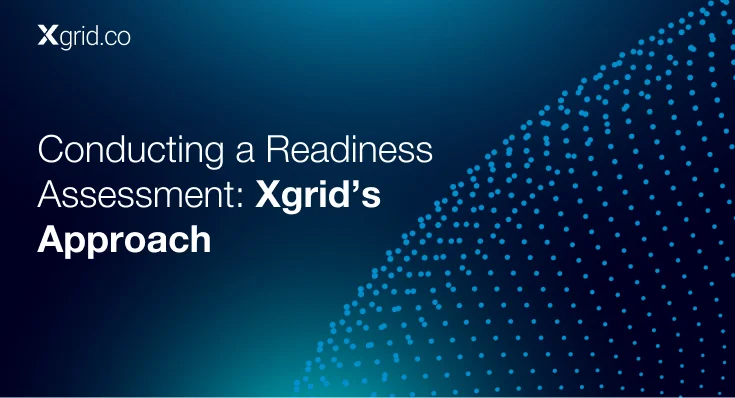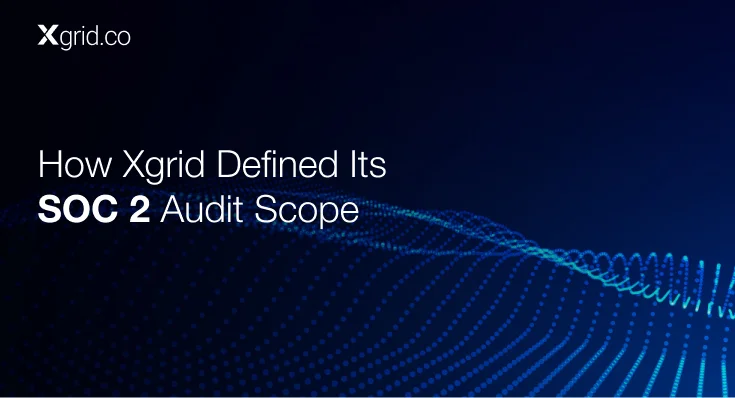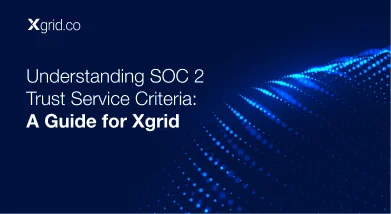Mapping Out Xgrid’s SOC 2 Compliance Journey
Achieving SOC 2 compliance wasn’t merely a strategic decision; it stands as a testament to our unwavering commitment to upholding the highest standards of data security and privacy.
This achievement reflects our dedication to building trust with our clients by consistently protecting their most valuable asset: their data.
This blog will guide you through Xgrid’s SOC 2 compliance journey, shedding light on the meticulous steps we took to align with the rigorous Trust Service Criteria.
From evaluating our security protocols and refining our processes to preparing for rigorous external audits, we’ll walk you through how we ensured that every aspect of our operations met the stringent requirements.
Along the way, we’ll also share the challenges we faced, the lessons we learned, and how this experience has shaped our ongoing approach to data security in an ever-evolving digital world.
What is SOC 2 Compliance?
Before diving into our journey, let’s briefly revisit what SOC 2 compliance entails. SOC 2, which stands for Service Organization Control 2, is a voluntary compliance standard for service organizations.
It is based on five Trust Service Criteria (TSC): security, availability, processing integrity, confidentiality, and privacy. For Xgrid, SOC 2 compliance meant demonstrating our ability to protect customer data in all aspects of our operations, ensuring that we meet the rigorous standards required by the American Institute of Certified Public Accountants (AICPA).
This framework not only requires us to establish and maintain stringent controls but also to regularly assess and validate these controls to ensure they remain effective over time.
Achieving SOC 2 compliance involves a thorough evaluation of our processes, systems, and practices to ensure that they align with industry best practices and meet the expectations of our clients and stakeholders.
It also reinforced our commitment to transparency and accountability, as we underwent external audits to validate our adherence to the SOC 2 criteria. Ultimately, SOC 2 compliance is not just a certification; it’s an ongoing commitment to maintaining the highest level of security and trust in our services.
Step 1: Initial Assessment – Laying the Groundwork
Every journey begins with a single step, and for Xgrid, that first step was a comprehensive initial assessment. We started by evaluating our existing infrastructure, processes, and policies to identify gaps that could pose risks to our compliance efforts.
This assessment was crucial in helping us understand the current state of our data security measures and determine what needed to be improved.
Key actions during this phase included:
Reviewing Current Security Practices: an in-depth review of our existing security practices, from how we handle data to how we respond to security incidents. This review helped us identify areas where we were already strong and areas where we needed improvement.
Engaging Key Stakeholders: SOC 2 compliance is not just an IT issue—it’s a company-wide initiative. We engaged key stakeholders across the organization, including executives, legal teams, and department heads, to ensure everyone understood the importance of SOC 2 compliance and their role in achieving it.
One of the critical decisions we made during this phase was defining the scope of the SOC 2 audit. We needed to determine which systems, processes, and services would be included in the audit. This step was essential in focusing our efforts and resources where they were most needed.
Step 2: Gap Analysis – Identifying Weaknesses
Once the initial assessment was complete, the next step was to conduct a gap analysis. This involved comparing our current practices with the SOC 2 Trust Service Criteria to identify any deficiencies or areas that required enhancement.
The gap analysis provided us with a clear roadmap of what needed to be addressed to achieve compliance.
Key findings from the gap analysis included:
Inconsistent Documentation: One of the most significant gaps we identified was the inconsistency in our documentation. While we had many robust processes in place, the documentation of these processes was often lacking. To achieve SOC 2 compliance, we needed to ensure that all our security practices were not only implemented but also thoroughly documented.
Access Controls: Another area of concern was access control. We found that while we had access controls in place, they were not as stringent or as regularly reviewed as they needed to be. Strengthening these controls became a top priority.
Vendor Management: Managing third-party vendors posed a challenge, as we needed to ensure that our vendors were also compliant with SOC 2 standards. This required us to implement more rigorous vendor management processes.
Step 3: Implementing Controls – Taking Action
With the gap analysis complete, the next step was implementing the necessary controls to address the identified weaknesses.
This phase of the journey was the most time-intensive, as it involved rolling out new policies, updating existing procedures, and ensuring that all employees were trained on the new standards.
Key actions during this phase included:
Enhancing Documentation: We undertook a massive effort to document all our processes and controls thoroughly. This documentation was not only a requirement for SOC 2 compliance but also a valuable resource for training new employees and ensuring consistency across the organization.
Strengthening Access Controls: We implemented more robust access controls, including multi-factor authentication (MFA) and regular access reviews. These measures helped ensure that only authorized personnel had access to sensitive data and systems.
Training and Awareness: We launched a company-wide training program to educate all employees about SOC 2 compliance and their role in maintaining it.This training was crucial in fostering a culture of security awareness across the organization.
Step 4: Continuous Monitoring – Maintaining Compliance
Achieving SOC 2 compliance is not a one-time effort—it requires continuous monitoring and maintenance. Once we had implemented the necessary controls, we established processes for ongoing monitoring to ensure that we remained compliant.
Key components of our continuous monitoring efforts include:
Regular Audits: We scheduled regular internal audits to review our compliance with SOC 2 standards. These audits help us identify any potential issues early and take corrective action before they become significant problems.
Incident Response: We refined our incident response plan to ensure that we could quickly and effectively respond to any security incidents. This plan includes clear procedures for reporting, investigating, and mitigating incidents.
Vendor Management: We implemented a continuous vendor management process to regularly assess the compliance of our third-party vendors. This process ensures that our vendors adhere to the same high standards of security and privacy that we do.
Step 5: Engaging an Independent Auditor – Validating Our Efforts
The final step in our SOC 2 compliance journey was engaging an independent auditor to validate our efforts. This external audit was crucial in providing third-party verification of our compliance with SOC 2 standards.
The auditor conducted a thorough review of our controls, documentation, and processes, and provided us with a SOC 2 report that we could share with our clients and partners.
Lessons Learned Along the Way
Our journey to SOC 2 compliance was not without its challenges, but it was also an invaluable learning experience. Some of the key lessons we learned include:
Start Early: SOC 2 compliance is a complex process that requires time and effort. Starting early gave us the time we needed to identify gaps, implement controls, and ensure compliance.
Engage the Entire Organization: Compliance is not just the responsibility of the IT department—it requires buy-in and participation from the entire organization. Engaging stakeholders early and often was key to our success.
Focus on Continuous Improvement: Compliance is not a one-time achievement—it requires ongoing effort. We have committed to continuous monitoring and improvement to ensure that we remain compliant and maintain the trust of our clients.
The Road Ahead
Mapping out Xgrid’s SOC 2 compliance journey was a challenging but rewarding process. Achieving compliance has not only strengthened our security posture but also enhanced our reputation as a trusted partner in the industry. As we move forward, we remain committed to maintaining the highest standards of data security and privacy, ensuring that our clients can continue to trust us with their most valuable assets.





